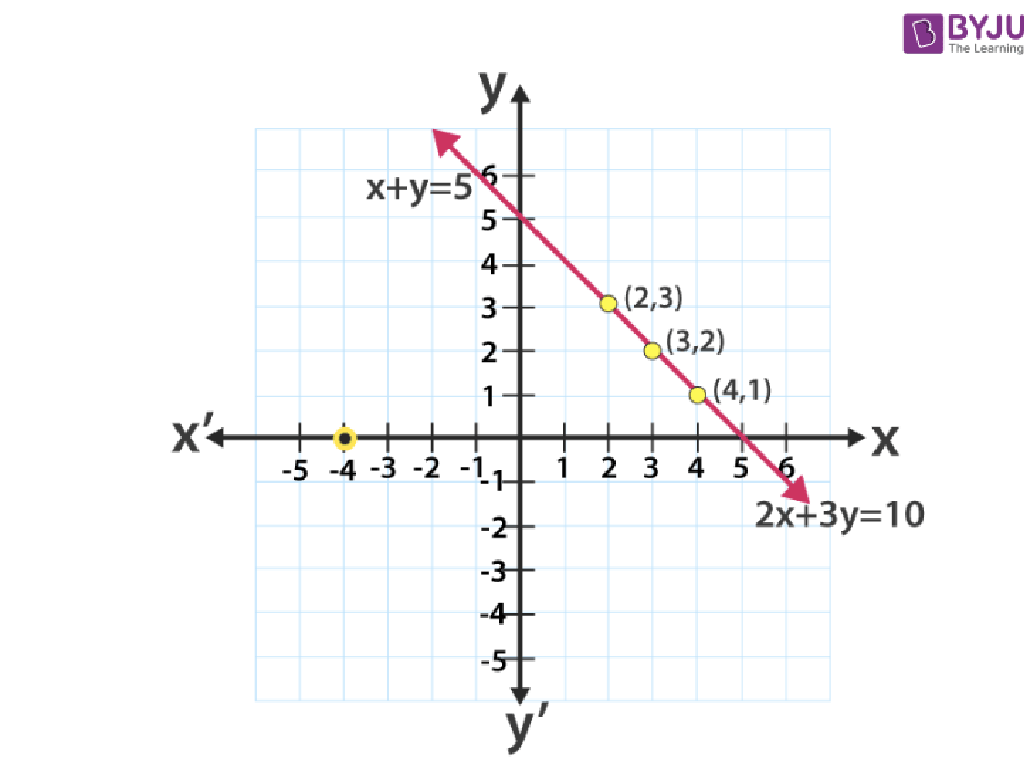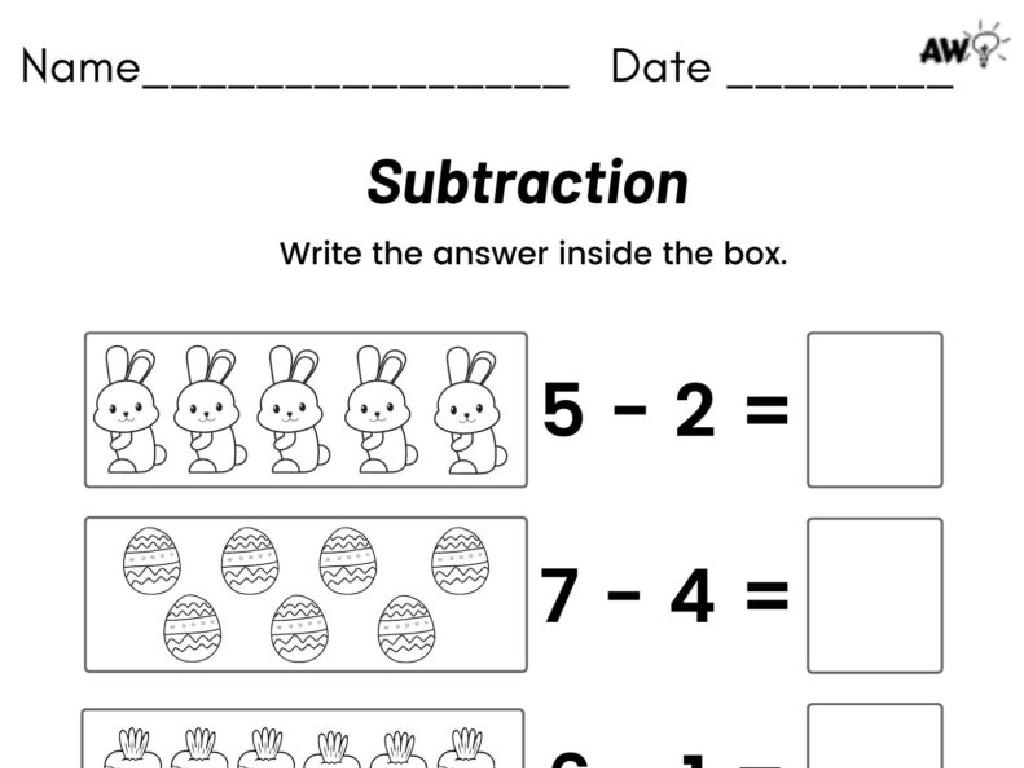Create Line Plots
Subject: Math
Grade: Fourth grade
Topic: Data And Graphs
Please LOG IN to download the presentation. Access is available to registered users only.
View More Content
Understanding Line Plots
– What is a line plot?
– A graph that displays data along a number line
– Steps to create a line plot
– Collect data, mark a number line, plot data points
– Reading a line plot
– Use plots to observe data distribution and range
– Significance of line plots
– Useful for comparing data and identifying trends
|
Today’s lesson introduces line plots, a type of graph that represents data along a number line. Start by explaining what a line plot is and how it is used to display frequency of data. Walk through the steps of creating a line plot: collecting data, drawing a number line, and plotting the data points above the corresponding values. Teach students how to read a line plot by looking at the distribution and range of the data. Emphasize the importance of line plots in math for organizing information, making it easier to compare and analyze data, and spotting trends. Provide examples and practice exercises to reinforce the concept.
Understanding Line Plots
– What is a line plot?
– A graph that shows data along a number line
– Marking data with ‘X’s
– Each ‘X’ marks a single occurrence of a value
– Visualizing data frequency
– Helps us count how often a value appears
– Analyzing data with line plots
– We can quickly see and compare data
|
Introduce the concept of a line plot as a simple and effective way to organize data visually. Explain that each ‘X’ on a line plot represents one instance of a data point and that by counting the X’s, we can determine the frequency of that data point. Emphasize how line plots make it easy to see which data points occur most often and to compare different values at a glance. Use examples like recording daily temperatures or tallying classmates’ favorite fruits to illustrate the concept. Encourage students to think of other types of data that could be represented with a line plot.
Creating Our Line Plot
– Step 1: Collect class shoe sizes
– We’ll measure everyone’s shoe size for data
– Step 2: Draw a horizontal number line
– Make sure it’s straight and evenly spaced
– Step 3: Place X’s for each shoe size
– Each X represents a pair of shoes in our data
– Step 4: Observe our line plot
|
This slide is designed to guide students through the process of creating a line plot with a practical example: their shoe sizes. Start by explaining the importance of gathering data and how it can be represented visually. When drawing the number line on the board, involve the students by asking them to help ensure it is straight and properly spaced. As you mark an X for each data point, explain that each X corresponds to a shoe size from the collected data. This will help them understand how individual data points contribute to the overall picture of the line plot. After completing the plot, take time to discuss what the plot shows us about the range and frequency of shoe sizes in the class.
Class Activity: Shoe Size Line Plot
– Collect shoe sizes from classmates
– Plot sizes on a line plot
– Mark each shoe size on the horizontal line
– Observe common shoe sizes
– See which sizes are most common
– Discuss line plot insights
– What does the line plot tell us about our class?
|
This class activity is designed to help students understand how to create and interpret line plots. Start by having each student write down their shoe size. Then, as a class, mark each shoe size on a line plot, using an ‘X’ or other symbols above the corresponding number on the horizontal axis. Once all data is plotted, guide the students to observe patterns, such as the most common shoe size. Discuss as a class what conclusions can be drawn from the line plot, such as the range of sizes and the average shoe size. This activity will provide a hands-on experience with collecting data, creating a visual representation, and interpreting the results.
Reading a Line Plot
– Learn to read data points
– Each mark represents a data point on the number line.
– Grasp the concept of frequency
– Frequency shows how often a data point appears.
– Answer questions using the plot
– Use the plot to solve problems: How many students got a score of 80?
– Practice with real examples
– Let’s use examples like class test scores or favorite fruits.
|
This slide aims to teach students how to interpret line plots, a key skill in understanding data. Start by explaining that a line plot displays data along a number line with Xs or other marks above numbers to represent frequency. Discuss how to count these marks to determine how often a data point occurs, which is the frequency. Then, move on to demonstrate how to answer questions about the data by looking at the plot, such as finding the most or least common data points. Finally, engage the students with hands-on practice by creating line plots from relatable data sets, such as scores from a spelling test or counts of different colored marbles in a bag. Encourage students to ask and answer questions about the data to reinforce their understanding.
Practice Time: Create Your Own Line Plot
– It’s your turn to make a line plot
– Use the provided data set
– Each number represents a piece of data
– Draw your line plot carefully
– Place a dot above each data value on the number line
– Be ready to present your findings
– Think about what story your data tells
|
This slide is designed to engage students in a hands-on activity where they will apply their knowledge of line plots. Provide a simple data set for the students to use, such as the number of apples picked from a tree each day over a week. Students should draw a horizontal number line and place a dot above the line for each data value. This exercise will help them understand how to organize and represent data visually. Encourage students to look at their completed line plots and think about what the data might be showing them, such as which day had the most apples picked. When they share their line plots with the class, they should explain their interpretation of the data. This activity will reinforce their understanding of line plots and data interpretation.
Class Activity: Our Favorite Fruits
– Vote for your favorite fruit
– Collect class fruit preferences
– Create a line plot as a class
– We’ll use the data to draw dots above each fruit name on the graph
– Discover the most popular fruit
– The fruit with the most dots is our class favorite!
|
This interactive class activity is designed to teach students how to create and interpret line plots. Start by having each student vote for their favorite fruit. Tally the votes and then work together to create a line plot on the board, with different fruits listed on the x-axis and the number of votes on the y-axis. Each vote will be represented by a dot above the corresponding fruit. This visual representation will help students understand how line plots work and clearly show which fruit is the most popular. Possible variations of the activity could include using stickers for votes, grouping students to work on plots in smaller teams, or even bringing in actual fruits for a more tactile experience.
Conclusion: Mastering Line Plots
– Recap: What’s a line plot?
– A graph that shows frequency of data along a number line
– Steps to create a line plot
– Gather data, mark a number line, plot data points
– Reading and interpreting line plots
– Look for trends, peaks, and gaps in the plotted data
– Why line plots matter
– Useful for comparing data and easy to read
|
As we wrap up, let’s review what we’ve learned about line plots. A line plot is a type of graph that displays data along a number line, making it easy to see how often each value appears. To create one, we first collect our data, then draw a number line that fits our data range, and finally plot our data points above the corresponding values. When reading a line plot, we can quickly identify trends, such as the most or least common data points, and understand the distribution of our data. Line plots are particularly useful because they provide a clear visual representation of data, which can be easier to interpret than lists of numbers. Encourage students to practice by creating their own line plots with data from their daily lives, like tracking the weather or their daily reading minutes.
Homework Challenge: Family Shoe Sizes Line Plot
– Create a line plot with family shoe sizes
– Bring your line plot to class
– Be ready to explain your line plot
– How did you organize the sizes? What patterns do you see?
– What does your line plot show?
– Does it show most common size, range of sizes, or trends?
|
This homework activity is designed to help students apply their knowledge of line plots to a real-world scenario that is familiar to them: their family’s shoe sizes. Students should collect the shoe sizes of their family members and plot them on a line plot, paying attention to the frequency of each size. When they bring their line plots to class, they should be prepared to discuss their findings, such as the most common shoe size, the range of sizes, and any other interesting patterns they may have noticed. This will help them understand how line plots can be used to organize and interpret data. The teacher should be ready to provide guidance on how to create a line plot and offer examples of questions to help students analyze their plots.





